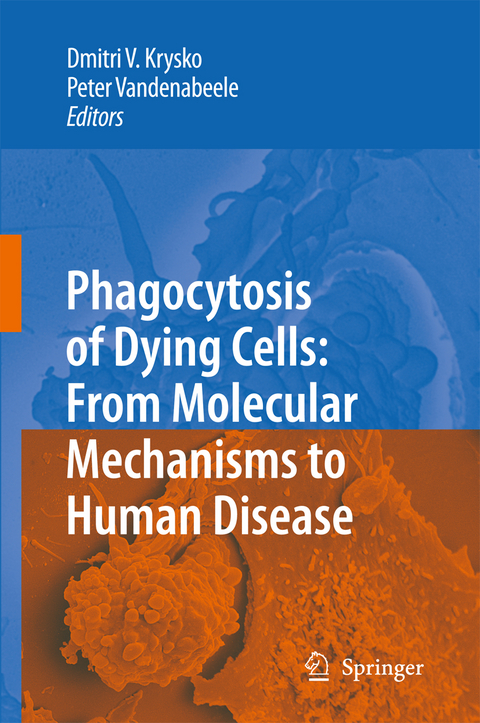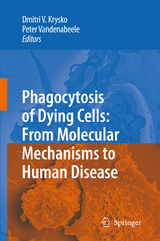Phagocytosis of Dying Cells
Springer-Verlag New York Inc.
978-1-4020-9292-3 (ISBN)
Phagocytosis has been at the forefront of cell biology for more than a century. Initially, phagocytosis, which comes from Greek words meaning “devouring cells,” was discovered in the late 19th century by Ilya Metchnikoff, who was awarded, together with Paul Ehrlich, the Nobel Prize in Physiology and Medicine in 1908 “in recognition of their work on immunity.” At that time Metchnikoff had already identified a function for phagocytes not only in host defense but also as scavengers of degenerating host cells during metamorphosis of tadpoles, thus providing one of the first descriptions of apoptotic cell clearance by macrophages (Kaufmann 2008). Since then, much has been learned about phagocytosis, and the previous several decades have witnessed outstanding progress in understanding the functions and the molecular mechanisms of phagocytosis. Two main types of targets are cleared by phagocytosis: microbial pathogens and dying cells. Rapid recognition and clearance of dying cells by phagocytes plays a pivotal role in development, maintenance of tissue homeostasis, control of immune responses, and resolution of inflammation. Clearance of dying cells can be divided into several stages, including sensing, r- ognition, binding and signaling, internalization, and immunological responses. In this book, our contributors address these different stages of dead cell cle- ance and examine how impaired clearance of dying cells may lead to human d- eases. We have attempted to provide sufficient cross-referencing and indexing to enable the reader to easily locate the ideas elaborated in the different chapters.
Molecular Mechanisms of Phagocytosis of Dying Cells.- Molecular Pathways of Different Types of Cell Death: Many Roads to Death.- Apoptotic, Autophagic and Necrotic Cell Death Types in Pathophysiological Conditions: Morphological and Histological Aspects.- Role of Attraction and Danger Signals in the Uptake of Apoptotic and Necrotic Cells and its Immunological Outcome.- Molecules Involved in Recognition and Clearance of Apoptotic/Necrotic Cells and Cell Debris.- Evolutionarily Conserved Pathways Regulating Engulfment of Apoptotic Cells.- Innate Apoptotic Immunity: A Potent Immunosuppressive Response Repertoire Elicited by Specific Apoptotic Cell Recognition.- Comparative Characterization of Non-professional and Professional Phagocyte Responses to Apoptotic Cells.- Methods Used to Study Apoptotic Cell Clearance.- Impairment of Phagocytosis of Dying Cells and its Role in the Development of Diseases.- Results of Defective Clearance of Apoptotic Cells: Lessons from Knock-out Mouse Models.- Clearance of Dying Cells and Systemic Lupus Erythematosus.- Apoptotic Cells for Therapy of Transplant Rejection.- Impact of Tumour Cell Death on the Activation of Anti-tumour Immune Response.- Phagocytosis of Dying Cells in the Pathogenesis of Atherosclerosis.- The Impact of Defective Clearance of Apoptotic Cells in the Pathogenesis of Chronic Lung Diseases: Chronic Obstructive Pulmonary Disease, Asthma and Cystic Fibrosis.- Environmental Factors Affecting Phagocytosis of Dying Cells:Smoking and Static Magnetic Fields.
| Erscheint lt. Verlag | 14.1.2009 |
|---|---|
| Zusatzinfo | X, 447 p. |
| Verlagsort | New York, NY |
| Sprache | englisch |
| Maße | 155 x 235 mm |
| Themenwelt | Medizin / Pharmazie ► Medizinische Fachgebiete ► Onkologie |
| Studium ► 1. Studienabschnitt (Vorklinik) ► Physiologie | |
| Studium ► Querschnittsbereiche ► Infektiologie / Immunologie | |
| ISBN-10 | 1-4020-9292-X / 140209292X |
| ISBN-13 | 978-1-4020-9292-3 / 9781402092923 |
| Zustand | Neuware |
| Informationen gemäß Produktsicherheitsverordnung (GPSR) | |
| Haben Sie eine Frage zum Produkt? |
aus dem Bereich




